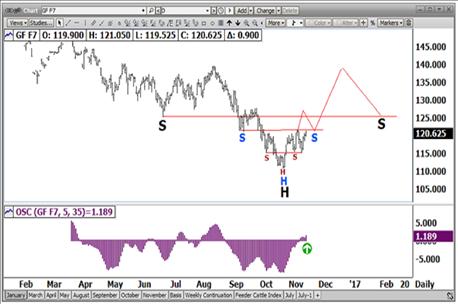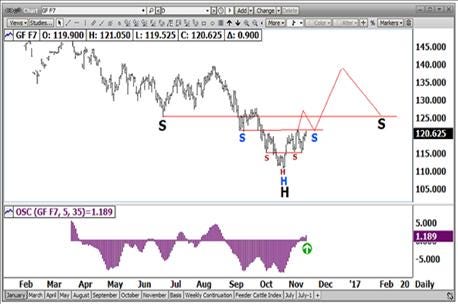
A new high from contract low, coupled with a reversal of the technical indicators at the current levels, leads me to anticipate a thrust to the upside.
This will be the first time this year technical indicators have turned back up after already having achieved an overbought status without having gone either below the zero line of the oscillator or below the 20 marker on the slow stochastics.

A bit more upside on the feeder chart would also solidify the first head-and-shoulders pattern and suggest we might anticipate January feeders reaching $127.50.
Most commodity markets are higher today, and with president-elect receiving a blessing from the equities markets, I anticipate further upside price movement in both commodities and equities. Money continues to get more expensive. Bonds have been another point lower this morning. Producers were given ample warning to the potential of this materializing. Lenders and producers will now be facing a bull market in rates.
I took notice of the encroachment of drought areas on the Palmer Drought Index map this morning. The southeast is a large nursery for the cow/calf sector of the industry. With some areas already having to feed hay, minor liquidation could begin moving some cattle toward slaughter. Also note on the index how the dryness is creeping into western portions of the western grain belt. I perceive these subtle changes, along with others noted, are enough to give thought to not being as bearish.
January feeders at $121.27 will have accomplished what is anticipated for the fats. A new high from contract low and a turn of indicators from an elevated level has not been seen all year in feeders.
This would also solidify the first head-and-shoulders pattern and lead me to anticipate the fulfillment of the next head-and-shoulders pattern. This suggests we might anticipate January feeders up to $127.50.
The drought may impact feeders to a small extent as well. With there being several small lots around the southeast that grow feeders, water may become an issue.
Recall that input costs at this time have no room to rise with margins at this level. This leads me to believe we might not necessarily see a change in numbers, but faster speed with which they are marketed. That may keep pounds off them. At this time, pounds are about the only variance there is to production.
About the Author(s)
You May Also Like




